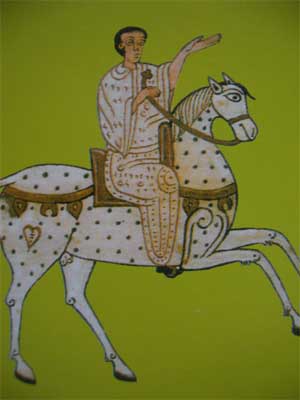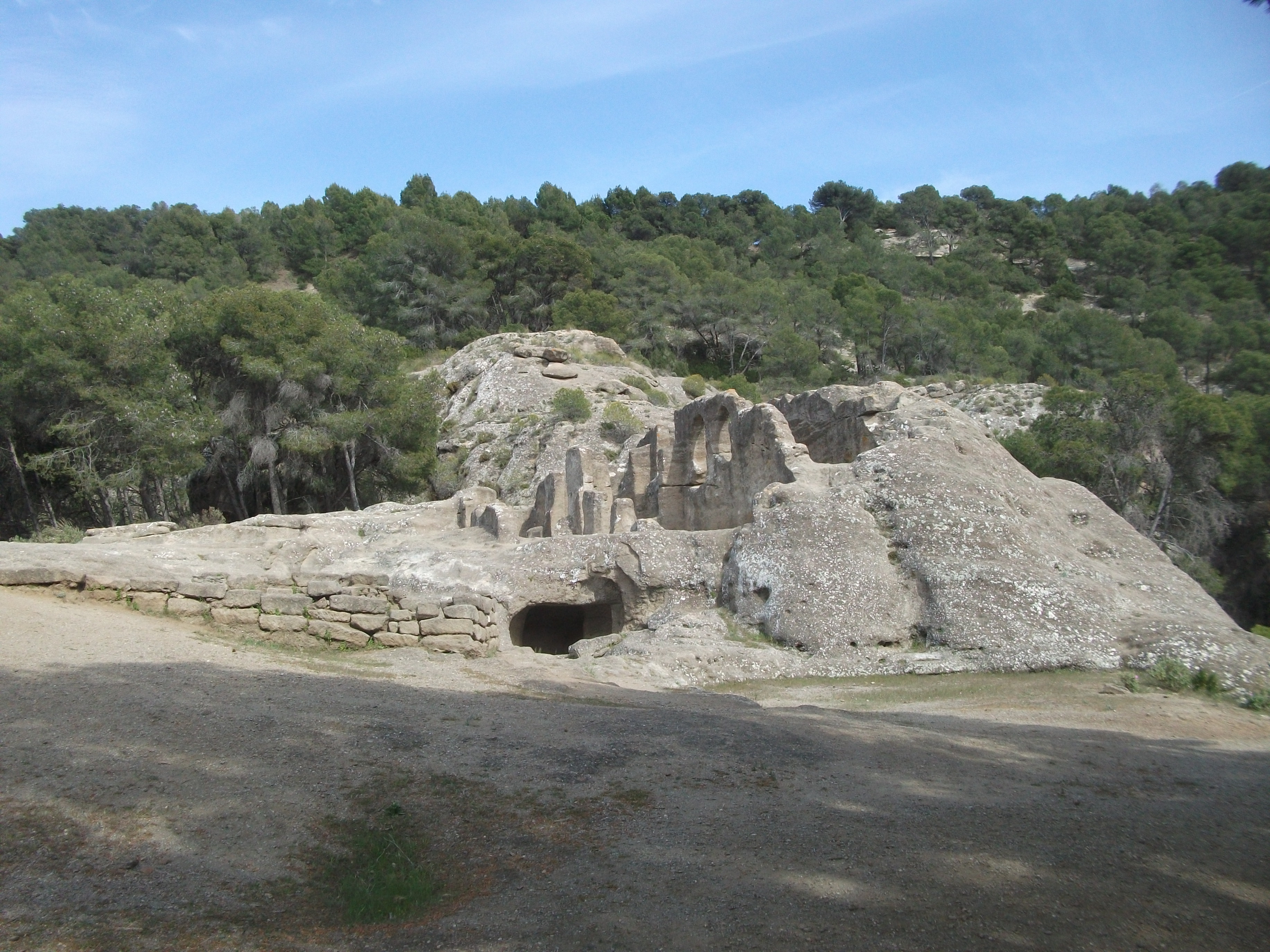The final years of his reign must have been bitter for Al Rahman III. He faced rebellion from all quarters, not least from a new adversary who had none of the lineage of centuries of rule in the lands of the Bible that the caliph had.
Omar Ibn Hafsun was born near to Parauta in the mountains near in what is now Málaga sometime around 850. His origins are obscure. One of his contemporaries refers to him as a descendent of black Africans, but another historian writing a hundred years later claims that his lineage went back to Visigoth kings. It is entirely possible that the second version was invented by Ibn Hafsun himself and passed on to posterity.
 Omar ibn Hafsun.
Omar ibn Hafsun.
Hafsun was an unruly boy, and soon involved himself with the wrong kind of people. He joined a group of brigands, and soon gained notoriety among the criminal and disaffected elements of the area. He had a violent temper, and he settled his disputes with the sword or knife. Before he was 30 he had become a murderer, and was arrested along with a group of other brigands in the Málaga area. The governor of Málaga was unaware of the murder charge, and fined him and the other thieves. They were released, and Hafsun fled to Morocco on the first ship. When the authorities found out, the governor was dismissed from his post. Hafsun laid low for a while working as a tradesman, and it was during this enforced hiatus that (according to the legend) he met an old man who told him to return to al-Andalus, where he would become a king and a leader of armies.
In 880 he did return to Málaga, and aided by his uncle, he joined a group of 40 other Christians, muladíes and Berbers, who were prepared to fight against their haughty Arab overlords. They decided to hide in the mountains and gorges of Alto Guadalhorce near to the town of Ard-Allah. (Ardales) It was here, in a place that was almost inaccessible, that they built Bobastro as their base from which to conduct guerrilla warfare against the forces of the caliph. They enlarged their domain by fortifying Ard-Allah and then capturing or inciting rebellion in local strongholds and towns.
 The ruins of Bobastro.
The ruins of Bobastro.
At first, the caliph considered them nothing more than a group of bandits, but in 882 when Hafsun formed an alliance with the King of the Basques, García Íñiguez, in a revolt against him, he realised that Hafsun was a man to be reckoned with. He was forced to send an army to Pamplona to put down the rebellion, and the armies met in battle near the town of Lumbier. The result was a crushing defeat for the rebels. Hafsun escaped and returned to Bobastro, but Íñiguez was killed.
When the caliph realised that Hafsun controlled towns and swathes of land around Cádiz, Jaén, Seville and Granada, and had allied himself with the populations of Archidona, Baeza, Úbeda and Priego, he began to pay careful attention to Hafsun and his followers. He sent his generals out to hunt him down, and eventually large force of the caliph’s army caught up with Hafsun and his men.
Hafsun saw a likely defeat and began negotiating a truce with al-Rahman. In return for the acknowledgement of the rights of his followers, and permission to live in peace with respect, he promised his obedience to the caliph. Hafsun fought several battles with the emir’s general, Hashim ibn Abd al-Aziz, and won the respect and praise of the caliph’s soldiers with his intelligence and courage. When he rode through Córdoba he was cheered by the crowds, and the caliph granted him the governorship of the Cora province with its capital in Archidona. Al Rahman invited him back to Córdoba and asked him to be his bodyguard. His loyal followers were to be the caliph’s guard of honour.
Things were going well for Ibn-Hafsun, but there is a saying that you can take the boy out of the gutter, but you can’t take the gutter out of the boy. The haughty Syrians who had elevated themselves to high positions in the governance of al-Andalus were not about to let this near barbarian and his crowd of rabble-rousers take over the city. Hafsun and his men were snubbed, humiliated, cheated and ridiculed. Everything that they were promised by the caliph was denied them.
In disgust and anger, Hafsun and his men returned to Bobastro and renewed their battle against their Arab lords. He seized the fortresses of Comeres, Mijas and Autha and formed alliances with other rebel groups which gave him control of a large part of southern al-Andalus. Al-Rahman now realised that he must quell Hafsun’s rebellion. He gave his sons, al-Mundhir and Abd Allah, command of his army and sent them out to put an end to his rampage. In 885 Hafsun moved his headquarters 80km north of Bobastro to the town of Poley, so that his forces could respond quickly to any threats.
The following year, (886) al-Mundhir surrounded Hafsun and his followers, who had allied themselves with another band of rebels, the Banu Rifá, in the town of Alhama, near to Granada, where he laid siege to them. The siege was beginning to take its toll on the rebels’ troops when news came that al-Rahman III had died. Al-Mundhir was forced to return to Córdoba to take over running al-Andalus. But Hafsun was not off the hook. Al-Mundhir wasted no time in organising successful assaults against Hafsun’s strongholds. His army drove Hafsun back and took Archidona, where the caliph ordered that the chief of the Christian rebels be crucified alongside a pig and a dog.
Luck was with Hafsun again in June 888 when he was besieged at Bobastro by the two brothers who had cut off all supply routes to the citadel. The siege was taking effect when al-Mundhir died. His brother, Abd-Allah, concealed his death for three days hoping that Hafsun would capitulate, but he had to raise the siege and return to Córdoba to take control of the caliphate. The retreat by Abd-Allah was now effectively a funeral cortege as they took the body back to Córdoba.
When Hafsun learned of the death, he sent his men out to loot the camp of his besiegers and chase the caravan of mourners. Abd-Allah sent the rebel leader a message to respect his dead brother, and to his surprise, Hafsun called his men off. The new caliph sent a train of 50 mules loaded with food and finery to Bobastro in gratitude, but Hafsun took the presents and continued his war against the new caliph. A furious Al-Mundhir sent back the message that he would be proclaimed caliph over al-Andalus over the dead bodies of the rebels at Bobastro.
Hafsun strengthened his alliances with other disaffected groups around Córdoba, Seville and Jaén. He captured Estepa, Osuna and Ecija in 889. At Baena he massacred the defenders causing Priego and all the towns around to surrender without a fight. By 891 the land under his control stretched from Jaén in the east to Seville in the west. To seek official legitimacy he began to collect taxes and sent emissaries to the Tunisian Aglabis who recognized the Baghdad caliph and then, when they were ousted, with their conquerors the Fatimíes, even though they were they were Shiites and most of al-Andalus were Sunnis. To show that the part of al-Andalus that he controlled was open to all religions he allowed Shiite imams to preach from Mosques controlled by Hafsun.
Hafsun suffered a crushing defeat in 981 when the lost a crucial battle against the caliph, al-Mundhir (now Abdullah ibn Muhammad al-Umawi) at Poley. Hafsun escaped, but the caliph ordered the massacre of all the Christians in Poley, and Hafsun was forced to move his headquarters back to Bobastro.
In 899 Hafsun made a mistake that lost him much of his support. In an effort to ally himself with the Caliphate of Córdoba’s biggest enemy, the Asturian King Alfonso III, Hafsun converted to Christianity and was baptised, taking the name of Samuel. He converted the small mosque at Bobastro into a Christian church and installed a Bishop.
Immediately he lost around half of his supporters. The Berbers and Arabs, his strongest followers, abandoned him. His respect and fame allowed him to continue for a few years more, but his hoped for ally, King Alfonso III, capitalised on Hafsun’s losses and made pacts with those disaffected with him. At the same time, the caliph of Córdoba was relentlessly eating into lands and towns under Hafsun’s control.
In 917 Hafsun died and was interred at Bobastro. His coalition crumbled and for a while his sons tried to maintain resistance, but Bobastro fell in 928 and the troops who had fought for Hafsun were absorbed into the armies of the caliph and sent to fight against the Galicians.
Hafsun’s remains along with the bodies of his dead sons were crucified and put on display outside the Great Mosque of Córdoba.
The golden age of al-Andalus was about to reach its glorious zenith. The first stones were being laid for the Shining City, which would become the cultural masterpiece of al-Andalus; but it was built on sand. Medina Azahara would only last for 70 years before it was sacked, abandoned and destroyed. Disputes within the caliphate led to civil wars, and caliphs came and were deposed or died with astonishing regularity, some of them only lasting a year. There were 16 caliphs between 929 and 1023.
But the doom of al-Andalus was decreed by an event in the homeland of its Arab rulers. In 1070 the Seljuk Turks had taken Jerusalem and began a systematic torture of the Christians who lived there. By 1095, the situation had become so bad that Byzantine Emperor Alexios I sent his envoys to Pope Urban II with an urgent message, asking for help from western Christians to liberate the region from the infidels. The pope gave a historic sermon at the Council of Clermont and urged the knights, princes and people of the Western Roman Empire to take up arms and to embark on the journey to "liberate" Byzantines or Eastern Christians from the "pagan race."
He said that "whoever for devotion alone, not to obtain honour or money, sets out to liberate church of god in Jerusalem, this will be counted for all his penance." The appeal by the Pope marked the beginning of the First Crusade. The incentive to drive Islam from Iberia had become a holy war.